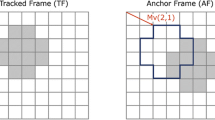Abstract
Motion estimation (ME) is the most important component of current video encoders, however, it presents a very high computational complexity. To deal with this complexity, fast ME search algorithms are widely used, since they can greatly speed up this process. Fast search algorithms are vulnerable to choose local minima, producing quality losses, and these losses are more significant when high-definition videos are considered. This work presents a new fast search algorithm for motion estimation, focusing on high-definition videos, named Iterative Random Search (IRS). The IRS algorithm randomly chooses candidate blocks from the reference frame, and, for the best candidates, an iterative refinement is done. The central position is also evaluated through an iterative process. By using this combination of strategies, the IRS becomes less susceptible to local minima falls. Achieved results show that, for 1080p sequences, IRS generates the highest quality results when compared to well known fast algorithms, such as Diamond Search, Four Step Search and Three Step Search. The quality gains can be higher than 4 dB, while the number of evaluated candidate blocks may increase, at most, 2.6 times. Additionally, the average quality loss against Full Search is 1.45 dB, while the number of evaluated candidate blocks can achieve a reduction higher than 200 times.








Similar content being viewed by others
References
Byun J, Choi J, Kim J (2010) A fast multi-reference frame motion estimation algorithm. IEEE Trans Consum Electron 56(3):1911–1917
Ghanbari M (2003) Standard codecs: image compression to advanced video coding. The Institution of Electrical Engineers, United Kingdom
International Organization For Standardization (1999) ISO/IEC 14496-2—MPEG-4 Part 2 (01/1999): coding of audio visual objects—ccccpart 2: visual. [S.l.]
Javed K et al (2010) An Enhanced Technique for Vertical Handover of Multimedia Traffic between WLAN and EVDO. Journal of Convergence 1(1):107–112
JCT-VC (2011) High Efficiency Video Coding (HEVC) text specification Working Draft 3. JCTVC-E603, JCT-VC Meeting, Geneva
Jing X, CHAU L (2004) An efficient three-step search algorithm for Block motion estimation. IEEE Transactions on Multimedia, [S.l.], 6(3) 435-438.
JVT Editors (T. Wiegand, G. Sullivan, A. Luthra) (2003) Draft ITU-T Recommendation and final draft international standard of joint video specification (ITU-T Rec.H.264 |ISO/IEC 14496-10 AVC), JVT-G050r1, Geneva
Kuhn P (1999) Algorithms, complexity analysis and VLSI architectures for MPEG-4 motion estimation. Kluwer Academic Publishers, Boston
Kuo C et al (2009) A novel prediction-based directional asymmetric search algorithm for fast block-matching motion estimation. IEEE Trans Circ Syst Video Tech 19(6):893–899
Lin Y et al (2008) A hardware-efficient H.264/AVC motion-estimation design for high-definition video. IEEE Trans Circ Syst 55(6):1526–1535
Mabanag R, Chong M, Tanaka T (2010) Motion Blur Identification Using Maxima Locations for Blind Colour Image Restoration. Journal of Convergence 1(1):49–56
Ndili O, Ogunfunmi T (2010) Hardware-oriented modified diamond for motion estimation in H.246/AVC. In: IEEE International Conference on Image Processing, p 749–752
Po L et al (2009) Novel directional gradient descent searches for fast block motion estimation. IEEE Trans Circ Syst Video Tech 19(8):1189–1195
Porto M et al (2011) Two fast multi-point search algorithms for high quality motion estimation in high resolution videos. Int J Information Technology, Communications and Convergence 1(4):410–420
Porto M et al (2007) Investigation of motion estimation algorithms targeting high resolution digital video compression. In: ACM Brazilian Symposium on Multimedia and Web pp 111–118
Puri A et al (2004) Video Coding Using the H.264/MPEG-4 AVC Compression Standard. Elsevier Signal Processing: Image Communication, [S.l.], n. 19, p 793–849
Tasdizen O, Hamzaoglu I (2010) Recursive dynamically variable step search motion estimation algorithm for high definition video. In: 20th International Conference on Pattern Recognition, ICPR 2010, pp 2354–2357
Tasdizen O et al (2009) Dynamically variable step search motion estimation algorithm and a dynamically reconfigurable hardware for its implementation. IEEE Trans Consum Electron 55(3):1645–1653
Trojahn T et al (2011) A Comparative Analysis of Media Processing Component Implementations for the Brazilian Digital TV Middleware. Int J Information Technology, Communications and Convergence 1(4):391–409
Urban F et al (2008) A flexible heterogeneous hardware/software solution for real-time HD H.264 motion estimation. IEEE Trans Circ Syst Video Tech 18(12):1781–1785
Wei S et al (2008) Adaptive motion search algorithms for fast H.264 inter prediction. Communications. In: International Conference on Circuits and Systems, ICCCAS pp 689–692
Xie L, Huang C, Chen B (2011) UMHexagonS Search Algorithm for Fast Motion Estimation. In: International Conference on Computer Research and Development, pp 483–487
Xiph.org: Test media, available at <http://media.xiph.org/video/derf/>, May, 2011
Zhu X, Ma K (2000) A new diamond search algorithm for fast block-matching motion estimation. IEEE Trans Image Process 9(2):287–290
Author information
Authors and Affiliations
Corresponding author
Rights and permissions
About this article
Cite this article
Porto, M., Cristani, C., Dall’Oglio, P. et al. Iterative random search: a new local minima resistant algorithm for motion estimation in high-definition videos. Multimed Tools Appl 63, 107–127 (2013). https://doi.org/10.1007/s11042-012-1033-0
Published:
Issue Date:
DOI: https://doi.org/10.1007/s11042-012-1033-0




